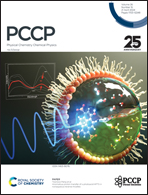A chiral metal cluster triggers enantiospecific electronic transport†
Abstract
Chirality is a geometric property of matter that can be present at different scales, especially at the nanoscale. Here, we investigate the manifestation of chirality in electronic transport through a molecular junction. Spinless electronic transport through a chiral molecular junction is not enantiospecific. However, when a chiral metal cluster, C3-Au34, is attached to the source electrode, a different response is obtained in spinless electronic transport between R and L systems: this indicates the crucial role of chiral clusters in triggering enantiospecific spinless electronic transport. In contrast, when an achiral metal cluster, C3v-Au34, is attached, no change in conductance occurs between enantiomeric systems. Using the non-equilibrium green's function method, we characterized this phenomenon by calculating the transmission and conductance of spin-unpolarized electrons. Our theoretical results highlight the importance of metal clusters with specific sizes and chiral structures in electronic transport and support previously published experimental results that exhibited enantiospecific scanning tunneling measurements with intrinsically chiral tips.

- This article is part of the themed collection: Size effects in chemistry & physics of atomic & molecular clusters, nanoparticles & nanostructures


 Please wait while we load your content...
Please wait while we load your content...